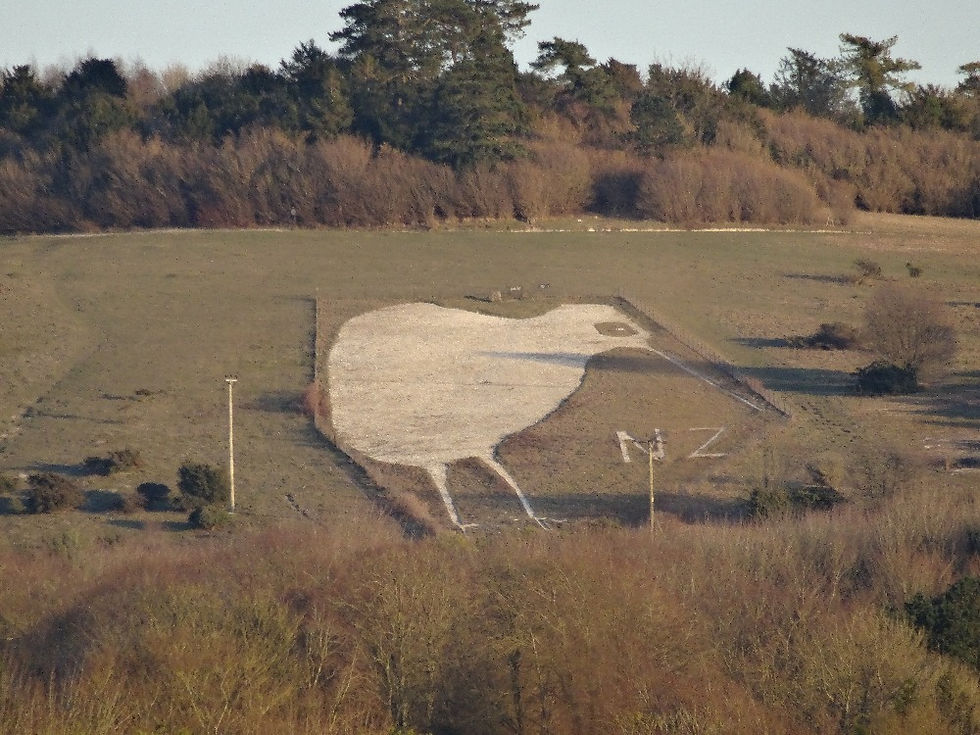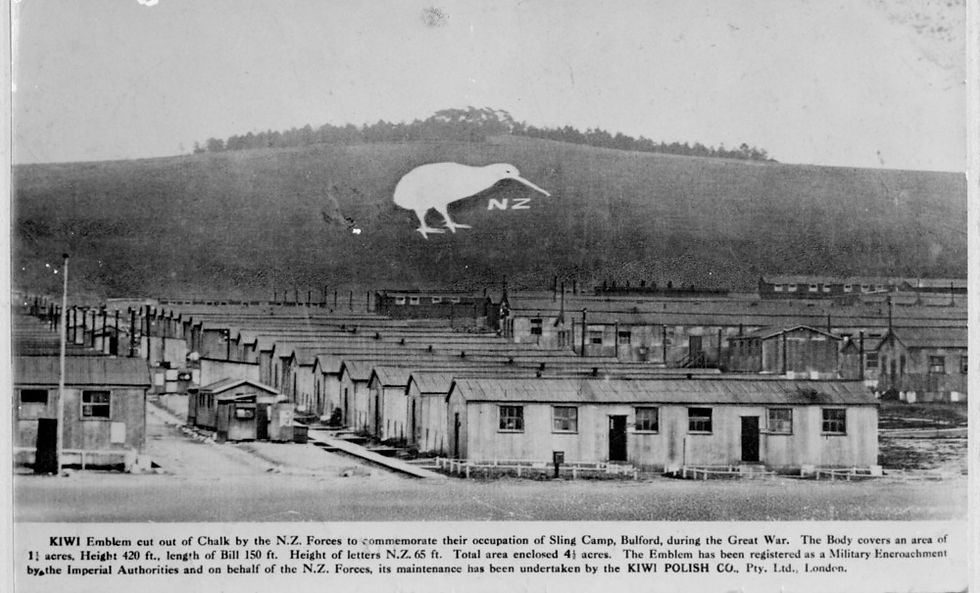THE BULFORD KIWI: A WALK WITH GREAT VIEWS, HISTORICAL INTEREST AND PERHAPS SOME RIFLE FIRE!
- Kate

- Apr 10, 2021
- 4 min read
Updated: Apr 11, 2021
The Bulford Kiwi is a large depiction of a kiwi cut into the chalk of Salisbury Plain by members of the New Zealand Expeditionary Force in 1919 above Bulford Ranges in Wiltshire. It makes a great place for a walk into the surrounding woods and into the remnants of the World War I trenches - both German and Allied, which the troops used for practice.

HISTORICAL BACKGROUND OF THE BULFORD KIWI
New Zealanders had originally arrived at Sling Camp on Beacon Hill in 1914 to train for combat in the Great War. Soldiers from here were sent to serve in the disastrous Gallipoli campaign in 1915. More thousands of NZ troops arrived in 1916 and trained here on the hillside for combat on the Western Front.

Sling Camp had four sub-camps – Auckland, Wellington, Canterbury and Otago – each with their own HQ and staff.
At the base of the hill was the YMCA, which included a cinema for recreation hours.
It was not, however, a popular billet. Private Stewart Callaghan wrote to his sister in 1917 “This is a rotten place”.
When the war ended many of the troops returned here to await repatriation. However, there were no troop ships immediately available, and frustration soon set in amongst those desperate to get home. There was overcrowding in the camp, influenza deaths, mundane military routines and great dissatisfaction.
In March 1919 a canteen and the Officers Mess were looted, and a few hundred soldiers rioted. The commanding officers promptly decided to keep the men occupied with the project of cutting out a giant emblem of their homeland into the chalk of the hill. The design was executed by Sergeant-Major Percy Blenkarne, a drawing instructor in the Education Staff, from a sketch of a stuffed kiwi specimen in the British Museum.
The troops finally got to close the gates of Sling Camp and head home in November 1919.

For a while the Kiwi was maintained by the Kiwi Polish Company. During WWII it was camouflaged with leaf mould to avoid Germain aircraft using it as a navigation marker in raids over Britain. Local Scouts removed the mould in 1948 and fresh chalk was added. The New Zealand government declined to maintain it in the 1950s and again in the 1980s, much to the contempt of the New Zealand army veterans.
In 2017 it was designated as a Scheduled Monument, and in 2018, 100 tons of chalk were ferried by Chinook helicopter to resurface the site. The British Army and Defence Infrastructure Organisation now maintain the Kiwi with some support from community groups and the New Zealand High Commission.
VISITING THE BULFORD KIWI
To see the Kiwi from the road you need to find the viewing point, clearly marked off the Bulford Droveway.
The afternoon is best, when the sun is shining on the Kiwi, otherwise it can be difficult to appreciate exactly what you are looking at. The white chalk stands out against the surrounding green vegetation.

You can only appreciate the size and scale of this national bird if you climb the hill and walk around the site.
Its height is 420 feet and the beak 150 feet long. It is surrounded by a modern wire fence and two gates.
Inside the south-east gate is a commemorative stone with a plaque. The climb, particularly if tackled at an oblique angle, is not over strenuous and the views are more than worth the effort!
The walk can then be extended northwards along the top of the hill through the scrub and juniper bushes to find the remains of the trenches dug so that the men could train for the Western Front.
You may hear the sound of small arms fire from below on the Bulford Rifle Ranges as you do so. The zigzag line of the “British” trenches can be clearly seen and also the round mounds that characterise the lines of “German” trenches. It is sobering to think of the many men who trained here but died in the carnage of France and Flanders.
An unofficial cairn has appeared near the trenches to honour those who took part in the war. 99 New Zealand soldiers and one New Zealand nurse are buried in the nearby Tidworth Military Cemetery.
For those wishing to trace the routes and places of New Zealanders who served in the Great War there is a specific government website called Nga Tapuwae (“in their footsteps”).
For those who look for more evidence of the New Zealand and Australian support during the Great War for the “home country” it is also possible go further south and to climb the hill to see the well known Fovant Badges. There are two more recently restored badges at Sutton Mandeville. The outline of Australia is visible at Compton Chamberlayne and there is an Australian military badge at Lamb Down near Codford St Mary.
VISITING THE BULFORD KIWI
How to get to the Bulford Kiwi
Postcode: SP4 9FB
what3words: putts.charging.rhino
Public Transport: 30 minutes by bus from Salisbury which leaves every 30 minutes. Try the X4. Find timetable >>
Parking: The viewing point is clearly marked on the Bulford Droveway, branching off the A3028. There are plenty of places along the Tidworth Road to leave the car and choose either an indirect and sloping rote to the Kiwi or to go directly up the hill.
When is the Bulford Kiwi open?
The site is open from dawn until dusk
How much does it cost to visit the Bulford Kiwi?
The site is free to visit and there are no charges for parking either.
Are there any facilities at the Bulford Kiwi?
There are no facilities but there are loos, shops and restaurants in the nearby military town of Tidworth, or a great pub to try is The Boot Inn at Shipton Bellinger.
Which is the nearest town to the Bulford Kiwi?
Salisbury is the nearest town. See our Salisbury City Guide for details on how to get to Salisbury, locally owned accommodation, restaurants and shops, further places to visit and things to do.










Comments